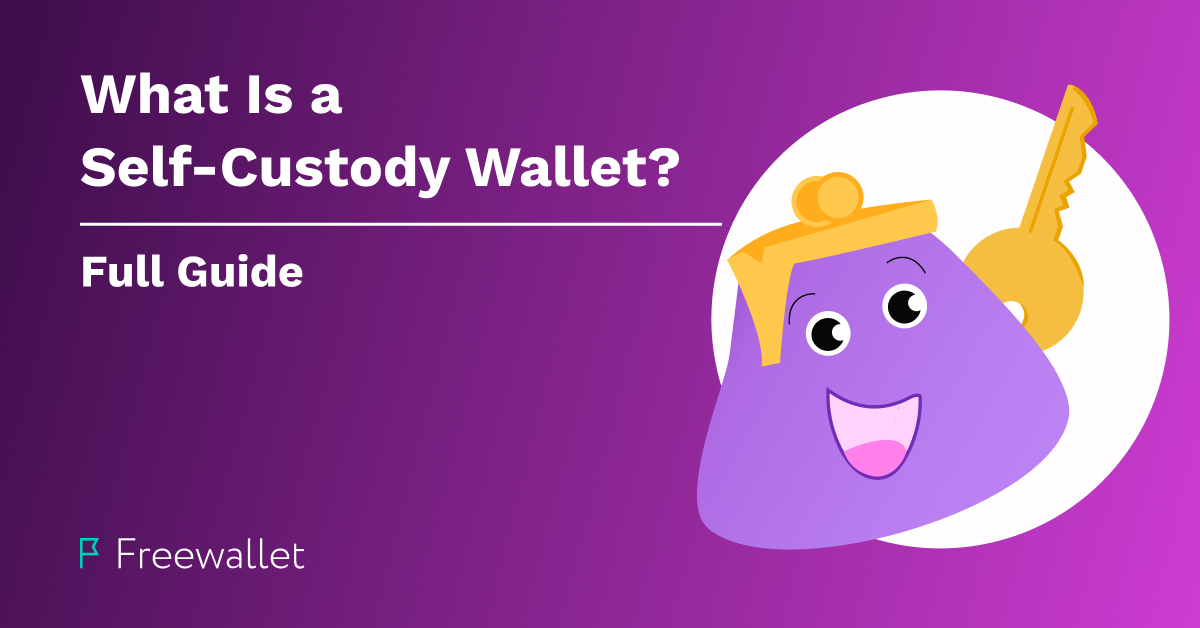
There are several types and classifications of cryptocurrency wallets. Mainly, wallets are distinguished by the way they store the private keys. The choice of a cryptocurrency wallet often revolves around finding the right balance between security and convenience.
Self-custody wallets, also known as non-custodial wallets, do not have access to users’ private keys. Instead, individuals store these keys themselves, giving them full control over their digital funds. In contrast, custodial wallets function similarly to traditional banks by holding users’ assets on their behalf. While the popular saying “not your keys, not your crypto” emphasizes the importance of personal key management, some users opt for custodial solutions for added convenience without considering the associated risks.
In this article, we delve into the concept of self-custody wallets, exploring their benefits and drawbacks, and providing guidance on how to safeguard your assets effectively.
Types of Crypto Wallets
Cryptocurrency wallets can be categorized based on various features. Multi-currency wallets support multiple cryptocurrencies, allowing users to manage all their digital assets in one place, while dedicated wallets focus on a single cryptocurrency, offering a more tailored experience.
Another key distinction is between hot wallets and cold wallets. Hot wallets are online wallets that are constantly connected to the internet, enabling quick and easy access for transactions on online platforms such as exchanges and payment portals. However, their online nature makes them vulnerable to cyber threats and unauthorized access. On the other hand, cold wallets operate offline, only connecting to the internet when initiating transactions. Cold wallets are considered more secure due to their offline storage, making them ideal for storing large amounts of cryptocurrency that are not frequently accessed.
One more classification. Image source: The Motley Fool
Additionally, cryptocurrency wallets can be classified as either custodial or self-custody wallets. All wallets use a pair of keys for transactions: a public key for receiving funds and a private key for authorizing transactions. While public keys can be shared safely, private keys must be kept secure to prevent unauthorized access to funds. Loss of the private key can result in the loss of funds, highlighting the critical importance of secure key management in cryptocurrency transactions.
The concept of private keys lies at the core of cryptocurrency security. Without the private key, users cannot access or transfer their digital assets, making it crucial to store this key securely. To enhance security, users can employ hardware wallets, which provide an extra layer of protection by storing private keys offline. Regularly backing up private keys and using secure passwords also play a crucial role in safeguarding cryptocurrency holdings.
Cryptocurrency wallets come in various forms, each offering a distinct approach to managing digital assets. Key among the wallet types are custodial and self-custody wallets, which differ primarily in how they handle private key ownership, a critical component in securing cryptocurrency holdings. Understanding the nuances between these two wallet categories is essential for users seeking to safeguard their funds effectively while balancing convenience and security.
Image source: Blockchain Simplified
In a custodial wallet setup, users relinquish direct access to their private keys, entrusting the wallet service provider to manage transactions on their behalf. The responsibility for safeguarding funds shifts to the wallet application’s developers and operators, making the security of the funds contingent on the robustness of the service provider’s security protocols. While custodial wallets may offer benefits such as data backup, password recovery assistance, and compensation in case of security breaches, users bear the risk of potential loss if the wallet provider encounters issues or proves untrustworthy.
Conversely, self-custody wallets empower users with direct control over their private keys, requiring them to manage key storage independently. This decentralized approach mirrors the relationship one might have with a physical wallet, where the responsibility for protecting assets lies solely with the owner. By storing private keys securely, users mitigate the risk of unauthorized access or theft, enhancing the overall security of their cryptocurrency holdings. Unlike custodial wallets, self-custody solutions do not involve relying on third parties for key management, offering users autonomy and reducing the potential for security vulnerabilities associated with centralized control.
The Benefits of Self-Custody Wallets
Self-custody wallets have gained popularity within the crypto community due to a myriad of advantages they offer:
1. Privacy: Self-custody wallets do not collect users’ personal data, ensuring greater privacy and anonymity.
2. Security: By not storing private keys on wallet servers, self-custody wallets are less susceptible to hacking attacks that could compromise user funds.
3. Censorship Resistance: Transactions made through self-custody wallets are immune to interference or censorship by outside authorities.
4. Quick withdrawals: The lack of KYC and similar procedures makes operations faster.
5. DeFi Compatibility: These wallets seamlessly integrate with decentralized finance platforms, allowing users to participate in DeFi protocols and decentralized applications easily.
6. Flexibility: Users can access their funds across multiple self-custody wallets using a single seed phrase, simplifying fund management and enhancing accessibility.
Drawbacks of Self-Custody Wallets
Despite their numerous benefits, self-custody wallets come with certain drawbacks, primarily centered around the heightened responsibility users assume for securing their funds:
1. Irreversible Loss: If a user misplaces or loses their seed phrase, the recovery of funds becomes practically impossible, emphasizing the need for careful seed phrase management.
2. Limited Support: Users with little experience in cryptocurrency management may find self-custody wallets more challenging to use compared to custodial options, which typically offer more user-friendly interfaces and support services.
3. Increased User Burden: Self-custody wallets require users to actively manage their seed phrases, demanding a higher level of diligence and awareness to maintain security effectively.
4. High Costs: Custodial wallets can cover a portion of the network fees while self-custody wallet users pay full fees.
How to Enhance Security on a Self-Custody Wallet?
Protecting your self-custody wallet involves two main areas: safeguarding your seed phrase (mnemonic phrase) and implementing measures to secure access to your account within the wallet app.
To begin with account security, non-custodial wallets, aiming for self-reliance, often do not offer popular security features like 2-factor authentication, which involves utilizing third-party software to generate time-based one-time passwords. However, these wallets do support alternative security methods such as PINs, passwords, biometric authentication, withdrawal limits, and more.
Image source: Ledger
In the unfortunate event of losing or damaging the device with the wallet app, recovering your funds is only possible through your seed phrase. It is crucial to take every precaution to prevent its loss. It is advisable to record the seed phrase immediately upon its generation during the initial setup of the wallet.
The words of the mnemonic should be noted in the correct sequence, possibly numbering each word as specific security protocols may require providing several words that go by the specific number in the phrase (let’s say, the third, the seventh, and the fifteenth word, etc). Store your seed phrase offline in a secure location, ensuring its confidentiality, easy retrieval, and protection from potential harm like water, fire, or other perils.
Conclusion
Self-custody wallets stand out for their lack of access to users’ private keys, setting them apart from custodial wallets. With a non-custody wallet, it is your responsibility to secure their funds, passwords, seed phrase, etc. These wallets prioritize user privacy and security, avoiding the collection of personal information and refraining from storing private keys on company servers.
Moreover, it is vital to protect the seed phrase (or mnemonic phrase) that grants access to your wallet account. Anyone with access to the seed phrase can execute all crypto-related actions stored in the wallet. Storing the seed phrase offline is recommended; you can jot it down or print it and keep it in a secure location away from potential theft, damage from water, fire, or other hazards. By following these security practices, you can better ensure the safety and integrity of your self-custody wallet and the assets it holds.
Related
Stay tuned
Subscribe for weekly updates from our blog. Promise you will not get emails any more often.
Most Popular
New Posts
Stay tuned
Subscribe for weekly updates from our blog. Promise you will not get emails any more often.






